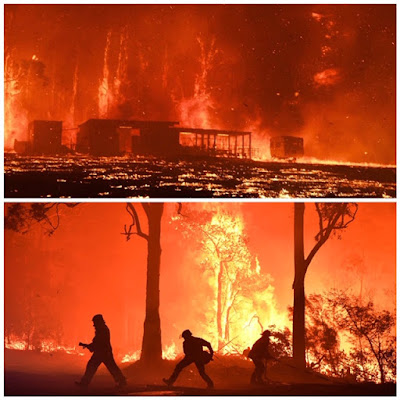It also means we are restricted to how we use fire to prepare the property. Unrestricted burn offs are prohibited and need a permit from the authorities. These permits lay out strict rules of how and when to burn.
We of course have a huge fire break around us after the December/January fires and despite some vigorous regrowth in the bush I think we are pretty safe this year.
The fire situation in the western states of the USA resonates with all of us who went through the trauma earlier this year of course.
So far this year, more than 8100 California wildfires have burnt 15,000 square kilometres, destroyed more than 7000 buildings and killed 26 people.Most of the losses occurred after a myriad of dry lightning strikes in mid-August ignited a massive outbreak of fires.
Fire worries were also developing on Monday across Southern California although it was unclear how strong predicted Santa Ana winds would be. Heat and extreme dryness were expected to be problematic nonetheless.
Conditions were also hot, dry and windy in parts of Arizona, where the Sears Fire in Tonto National Forest north of Phoenix has grown to more than 36 square kilometres since it erupted on Friday afternoon. Authorities reported zero containment.
Australia is sending 55 specialised firefighters to California mainly in leadership roles for up to a month.
They include operational commanders to supervise teams on the ground, as well as heavy plant supervisors to work with crews that clear land to make fire breaks.There has also been a request for a small group of specialised aircraft managers.
Australia is sending 55 specialised firefighters to California mainly in leadership roles for up to a month.
They include operational commanders to supervise teams on the ground, as well as heavy plant supervisors to work with crews that clear land to make fire breaks.There has also been a request for a small group of specialised aircraft managers.
Of course this exchange has its problems with the rampant Covid situation in the USA.
Special measures have been introduced to protect our firefighters from infection.2020 marks the 20th year of the exchange of firefighters between Australia and the United States.
A little bit of good news for us is the Bureau of Meteorology (BOM) has declared a La Niña event has developed in the Pacific Ocean, which could bring cooler days and more rainfall across much of Australia through spring.
La Niña is the cool phase of the El Niño Southern Oscillation and associated with cooler than average sea surface temperatures in the central and eastern tropical Pacific Ocean.
La Niña events typically form in autumn and winter and reach their peak in spring and early summer.
The last La Niña occurred from 2010-2012 and brought widespread flooding and record rainfall. The BOM said its modelling currently suggested the latest event would be strong but would not reach the same intensity.
The BOM also said that the Indian Ocean Dipole was also in negative territory and five out of six surveyed models indicated it would remain in a negative phase during October.
Both La Niña and a negative Indian Ocean Dipole typically increase the chance of above average rainfall across much of Australia during spring.
An active La Niña would also reduce the bushfire risk this season slightly, but would not eliminate it.
The last La Niña occurred from 2010-2012 and brought widespread flooding and record rainfall. The BOM said its modelling currently suggested the latest event would be strong but would not reach the same intensity.
The BOM also said that the Indian Ocean Dipole was also in negative territory and five out of six surveyed models indicated it would remain in a negative phase during October.
Both La Niña and a negative Indian Ocean Dipole typically increase the chance of above average rainfall across much of Australia during spring.
An active La Niña would also reduce the bushfire risk this season slightly, but would not eliminate it.





















No comments:
Post a Comment